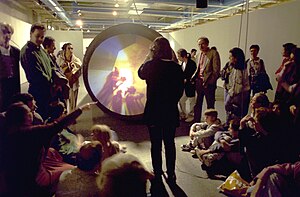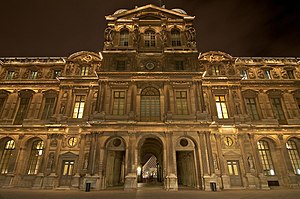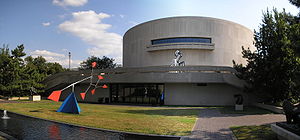Black cube art museum
A black cube (or black box) art museum is a term used by some scholars[who?] referring to the type of art museum that is architecturally designed or renovated with special consideration for the particular needs of modern digital art, installation art, and video art.[1] The development of the black box art museums originated from a need to accommodate these works in a better way than was previously possible in earlier art museums in the classic style (e.g., the Louvre in Paris) or "white cube gallery" style (e.g., the Museum of Modern Art in New York). Although earlier examples exist,[where?] black cube museums have been most prevalent from the 1990s onwards.

Development[edit]
Architectural shifts in the design of art galleries have always followed shifts in art itself. Just as white cube museums embraced modernist artwork and perception, black cube museums originated to house and adopt the zeitgeist of avant-garde video works and installations. Perhaps more importantly, there were also practical issues where the avant-garde works poorly functioned in white cube or classical museums. These issues could not be solved by anything less than an entirely new architectural thinking.[citation needed]

Problems with video art and installations[edit]
When interactive video art was first considered for exhibitions in the respected public galleries, curators found the spaces in traditional galleries were incredibly unsuited to the new medium.[citation needed] The traditional art galleries had static walls designed to display 2D artworks in a hierarchal manner or 3D sculpture where it could be viewed from all angles. Out of all the mediums through which art was expressed and displayed in a gallery, none demanded so much input from the viewer's themselves. When several artists began London Video Arts (LVA), their interactive art was arranged by Tate Gallery in ways which severely hampered the way they communicated with viewers. David Hall's work reflected the movement of audiences themselves by showing images taken from a camera (facing the viewers) on a single monitor. The work was placed in a lecture room in the basement of the Tate's Education Department. The curators claimed this environment was the most appropriate since too much lighting would make it difficult to see the monitors so often used in video art.
Before moveable walls became commonly used in art museums, Installation artworks posed severe difficulties for curators. In 1960, the curators of MoMA were bewildered when Jean Tinguely and Billy Klüver created a machine that destroyed itself for the 27 minute Homage to New York exhibition. Even today, traditional museums have to go to great and expensive lengths to exhibit what has become a well-respected medium. When the Museum of Contemporary Art Australia displayed Olafur Eliasson's Take your time, walls were cut, doorways made taller and rooms darkened for the exhibition. It was becoming clear to architects that considerations would need to be made for installations, video art and digital interactive art in future galleries.


Solutions offered by black cube[edit]
Many projected images or monitors are optimally viewed in low lighting. Therefore, the implementation of adjustable lighting systems was the most obvious consideration made by black cube museums. However many installations require the space itself to be controlled. The typical black cube museum would hence have movable walls in its interior. Some artists may even have preferences as to the temperature of the environment. The essential idea behind the black cube museums is that the museum should be malleable to the needs of any artwork. The Pompidou Centre is early architectural evidence of this way of thinking. However, in the Pompidou Centre, the high-tech architecture form of the museum itself influences the way the artwork is viewed. The majority of black cube museums prefer to develop an environment in which artworks can be viewed objectively, an idea taken from modernist white cube museums.[citation needed]
The future[edit]
Threats to the black cube[edit]
New forms of art constantly develop and art museums must adapt alongside. Some black cube museums such as the Australian Centre for the Moving Image (ACMI) have a large focus on film works or interactive works that use a simple keyboard and mouse. There is an argument that these works can be equally viewed from home through the internet. Indeed, some developing avant-garde forms of artwork are designed primarily to be viewed online. Works such as Automated Beacon,[2] a feedback loop of the Google search engine designed by Thomson & Craighead in 2005, perform very efficiently the role of the avant-garde and make us question "what is art?"
Black cube's future[edit]
The Internet may be the modern Library of Alexandria but, from the perspective of art, it suffers the same flaw as classical museums. Just as the old halls of the Louvre force an artist unto two-dimensional work if he wishes to be displayed in the classical museum, so too does the Internet force all its content to conform unto the easily accessible web page. Black cube museums however, with their flexible and accommodating interiors, allow the artist total control of what we objectively experience. Able to house any form of mainstream artwork, it seems unlikely that modern black cube museums can be entirely made redundant by the Internet.
Examples of black cube museums[edit]

- The New Museum of Contemporary Art, New York
- The Matthew Marks Gallery and The Paul Morris Gallery, New York
- The Max Protetch Gallery, New York
- Postmasters Gallery, New York
- Julia Friedman Gallery, New York
- The Hirshhorn Museum and Sculpture Garden, Washington, D.C.
- The Palm Beach Institute of Contemporary Art (PBICA), Florida
- Matt's Gallery, London
- The Tate Modern, London
- The Lisson Gallery, London
- The Foundation for Art and Creative Technology (FACT), Liverpool, UK
- The ZKM Museum of Contemporary Art, Karlsruhe,
- Australian Centre for the Moving Image (ACMI), Melbourne, Australia
See also[edit]
References[edit]
- ↑ "Black Cube Art Museums : Who, What, Where, When". Servinghistory.com. Retrieved 2014-03-20.
- ↑ automatedbeacon.net
Further reading[edit]
- Dixon, Steve (2007). Digital Performance: A History of New Media in Theater, Dance, Performance Art, and Installation, MIT Press, Cambridge, USA.
- Kyle, Nick (2007). Multi-media, Video, Performance, Routledge, New York, USA.
- Manasseh, Cyrus (2009). The problematic of video art in the museum, 1968–1990, Cambria Press, Amherst, New York, USA.
External links[edit]
- Examples of Internet art
- Further links to Internet art
This article "Black cube art museum" is from Wikipedia. The list of its authors can be seen in its historical and/or the page Edithistory:Black cube art museum. Articles copied from Draft Namespace on Wikipedia could be seen on the Draft Namespace of Wikipedia and not main one.
